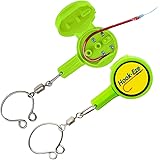Bass fishing is a thrilling sport that requires skill, patience, and knowledge. It’s not just about casting your line into the water and waiting for a bite; it takes practice and dedication to become an expert in this art. In this blog post, we will explore some tips and techniques on how you can catch the biggest bass yet!
Introduction to Bass Fishing
Bass are one of the most popular gamefish species in North America. They are known for their strength, aggressiveness, and intelligence, making them a challenging target for anglers. There are several types of bass, including largemouth, smallmouth, spotted, and striped bass. Each type has its unique characteristics, behavior patterns, and habitats. To be successful at bass fishing, you need to understand these differences and adjust your tactics accordingly.
The Art of Lure Selection
One key aspect of bass fishing is selecting the right lures. The choice of lure depends on various factors such as the time of day or night, weather conditions, water clarity, and depth. Some common lures used for bass fishing include crankbaits, jigs, plastic worms, spinnerbaits, and topwater baits. You should experiment with different lures until you find what works best for you. Remember, the goal is to imitate the natural prey of bass so they feel comfortable striking your lure.

Understanding the Behavior of Bass
To catch big bass, you must first understand their behavior. Bass are opportunistic feeders and will strike when they see something tasty floating by. They prefer hiding places like rocks, logs, and vegetation where they can ambush their prey. During warm summer months, bass tend to move deeper into the water column during the day and come shallow at dawn and dusk to feed. Understanding these behaviors will help you determine where to cast your line and which lures to use.
Techniques for Catching Big Bass
There are many techniques for catching big bass, but here are a few tips to get started:
Use a slow and steady retrieve when using crankbaits and jigs. This mimics the swimming motion of smaller fish, triggering the instinctual response of bass to attack.
Work your plastic worms slowly along the bottom, twitching them occasionally to create movement. This technique simulates injured or dying baitfish, which often attracts large predators like bass.
When using topwater baits, make sure to give the lure a little twitch every now and then to simulate the movements of a wounded minnow.
Always keep an eye out for signs of activity such as splashes, ripples, or birds diving into the water. These indications could mean there are schools of baitfish or other food sources nearby, which may draw in larger bass.
Tips for a Successful Bass Fishing Trip
Here are some final tips to ensure a successful bass fishing trip:
Choose the right location based on the season and time of day/night. Research local hotspots online or ask fellow anglers for recommendations.
Make sure to bring appropriate gear and tackle suited for bass fishing. A good quality rod and reel combo, sharp hooks, and strong line are essential.
Dress appropriately for the weather and wear sunscreen if necessary. Comfortable shoes and clothing are also important since you may spend long hours standing on the shore or boat.
Stay patient and focused. Don’t get discouraged if you don’t catch anything immediately. Keep trying new techniques and lures until you find what works.
Conclusion and Final Thoughts
In conclusion, bass fishing is both an exciting and rewarding pastime. With the right skills, knowledge, and equipment, anyone can enjoy the thrill of catching big bass. Whether you’re a beginner or experienced angler, always remember to respect nature and follow proper conservation practices to preserve our aquatic resources for future generations. Good luck and happy fishing!






























































